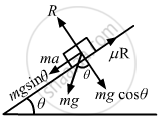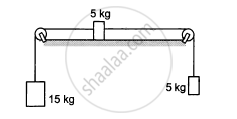Advertisements
Advertisements
Question
The friction coefficient between a road and the type of a vehicle is 4/3. Find the maximum incline the road may have so that once had brakes are applied and the wheel starts skidding, the vehicle going down at a speed of 36 km/hr is stopped within 5 m.
Solution
Given,
initial velocity of the vehicle, u = 36 km/h = 10 m/s
final velocity of the vehicle, v = 0
s = 5m, μ = `4/3`, g = 10 m/s2
Let the maximum angle of incline be θ.
Using the equation of motion
`a=(v^2-u^2)/(2s)=(0-10)/(2xx5)`
= -10 m/s2
From the free body diagram
R − mg cos θ = 0
⇒ R = mg cos θ (1)
Again,
ma + mg sin θ − μ R = 0
⇒ ma + mg sin θ − μmg cos θ = 0
⇒ a + g sin θ − μg cos θ = 0
`=>10+10sintheta-(4/3)xx10cos theta = 0`
⇒ 30 + 30 sin θ − 40 cos θ = 0
⇒ 3 + 3 sin θ − 4 cos θ = 0
⇒ 4 cos θ − 3 sin θ = 3
`=>4sqrt(1-sin^2theta)` = 3 + 3 sin θ
On squaring, we get
16 (1 − sin2 θ) = 9 + 9 sin2 θ + 18 sin θ
25 sin2 θ + 18 sin θ − 7 = 0
`=> sintheta=(18+sqrt(18^2-4(25)(-7)))/(2x25)`
`=(-18+32)/50=14/50=0.28` (Taking positive sign only)
⇒ θ = sin-1 (0.28) = 16°
Therefore, the maximum incline of the road, θ = 16°.
APPEARS IN
RELATED QUESTIONS
A body of mass M is kept on a rough horizontal surface (friction coefficient = μ). A person is trying to pull the body by applying a horizontal force but the body is not moving. The force by the surface on A is F, where
Let F, FN and f denote the magnitudes of the contact force, normal force and the friction exerted by one surface on the other kept in contact. If none of these is zero.
(a) F > FN
(b) F > f
(c) FN > f
(d) FN − f < F < FN + f.
A block is placed on a rough floor and a horizontal force F is applied on it. The force of friction f by the floor on the block is measured for different values of F and a graph is plotted between them.
(a) The graph is a straight line of slope 45°.
(b) The graph is a straight line parallel to the F-axis.
(c) The graph is a straight line of slope 45° for small F and a straight line parallel to the F-axis for large F.
(d) There is a small kink on the graph.
A block is projected along a rough horizontal road with a speed of 10 m/s. If the coefficient of kinetic friction is 0.10, how far will it travel before coming to rest?
A block of mass m is kept on a horizontal table. If the static friction coefficient is μ, find the frictional force acting on the block.
A body starts slipping down an incline and moves half metre in half second. How long will it take to move the next half metre?
If the tension in the string in the following figure is 16 N and the acceleration of each block is 0.5 m/s2, find the friction coefficients at the two contact with the blocks.

The friction co-efficient between the table and the block shown in the following figure is 0.2. Find the tensions in the two strings.

In the following figure shows two blocks in contact sliding down an inclined surface of inclination 30°. The friction coefficient between the block of mass 2.0 kg and the incline is μ1, and that between the block of mass 4.0 kg and incline is μ2. Calculate the acceleration of the 2.0 kg block if (a) μ1 = 0.20 and μ2 = 0.30, (b) μ1 = 0.30 and μ2 = 0.20. Take g = 10 m/s2.

A block of mass M is kept on a rough horizontal surface. The coefficient of static friction between the block and the surface is μ. The block is to be pulled by applying a force to it. What minimum force is needed to slide the block? In which direction should this force act?
Consider the situation shown in the following figure. Suppose a small electric field E exists in the space in the vertically charge Q on its top surface. The friction coefficient between the two blocks is μ but the floor is smooth. What maximum horizontal force F can be applied without disturbing the equilibrium?
[Hint: The force on a charge Q bye the electric field E is F = QE in the direction of E.]

A block of mass m slips on a rough horizontal table under the action of a horizontal force applied to it. The coefficient of friction between the block and the table is μ. The table does not move on the floor. Find the total frictional force applied by the floor on the legs of the table. Do you need the friction coefficient between the table and the floor or the mass of the table?
A person (40 kg) is managing to be at rest between two vertical walls by pressing one wall A by his hands and feet and the other wall B by his back (in the following figure). Assume that the friction coefficient between his body and the walls is 0.8 and that limiting friction acts at all the contacts. (a) Show that the person pushes the two wall with equal force. (b) Find the normal force exerted by either wall on the person. Take g = 10 m/s2.

In the following figure shows a small block of mass m kept at the left end of a larger block of mass M and length l. The system can slide on a horizontal road. The system is started towards right with an initial velocity v. The friction coefficient between the road and the bigger block is μ and that between the block is μ/2. Find the time elapsed before the smaller blocks separates from the bigger block.

The coefficient of static friction between a wooden block of mass 0.5 kg and a vertical rough wall is 0.2. The magnitude of horizontal force that should be applied on the block to keep it adhered to the wall will be ______ N. [g = 10 ms-2]
